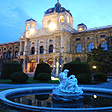SCHÖNBRUNN PALACE & PARK
Imperial Habsburg Majesty in Vienna Suburbs
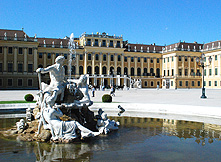 The Imperial Palace of Schoenbrunn, originally the country estate getaway for the Habsburg royal family is now a fifteen minute train ride from the center of Vienna and Austria’s most popular tourist attraction. Schönbrunn Palace with its magnificent grand façade of distinctive yellow and connected building, with huge formal gardens and parkland of walking pathways of flowered plazas and fountains, takes up the space of a small city on its own. Schönbrunn Palace, its name meaning “beautiful spring” which became a UNESCO World Heritage site in 1996, has been the primary summer palace of the Hapsburg dynasty since Holy Roman Emperor Maximillian II first acquired the property as a game preserve along the Wien River.
The Imperial Palace of Schoenbrunn, originally the country estate getaway for the Habsburg royal family is now a fifteen minute train ride from the center of Vienna and Austria’s most popular tourist attraction. Schönbrunn Palace with its magnificent grand façade of distinctive yellow and connected building, with huge formal gardens and parkland of walking pathways of flowered plazas and fountains, takes up the space of a small city on its own. Schönbrunn Palace, its name meaning “beautiful spring” which became a UNESCO World Heritage site in 1996, has been the primary summer palace of the Hapsburg dynasty since Holy Roman Emperor Maximillian II first acquired the property as a game preserve along the Wien River.
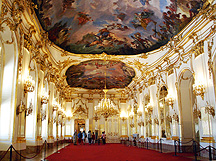 Emperor Leopold I built the original palace on the grounds beginning in 1696 with a design intended to outshine France’s Versailles, but Schonbrunn is probably most associated with the Empress Maria Theresa who took the improvement of the palace as a personal project, reconstructing much of it in late Baroque and Rococo style, with the original furnishings and decorations now seen in the palace mostly from Maria Teresa's time. Napoleon Bonaparte occupied the palace from 1805 to 1809. After Napoleon's defeat (see Waterloo
Museums) and abdication from France (see Napoleon's
Chateau Fontainebleau) his Austrian second wife Empress Marie Louise brought their son to live at Schonbrunn. Emperor Franz Josef I was born at the palace and lived there for much of his life. He died in the Emperor's Sleeping Room seen on the palace tour.
Emperor Leopold I built the original palace on the grounds beginning in 1696 with a design intended to outshine France’s Versailles, but Schonbrunn is probably most associated with the Empress Maria Theresa who took the improvement of the palace as a personal project, reconstructing much of it in late Baroque and Rococo style, with the original furnishings and decorations now seen in the palace mostly from Maria Teresa's time. Napoleon Bonaparte occupied the palace from 1805 to 1809. After Napoleon's defeat (see Waterloo
Museums) and abdication from France (see Napoleon's
Chateau Fontainebleau) his Austrian second wife Empress Marie Louise brought their son to live at Schonbrunn. Emperor Franz Josef I was born at the palace and lived there for much of his life. He died in the Emperor's Sleeping Room seen on the palace tour.
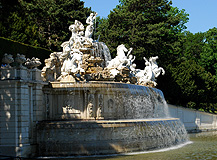 The garden park first opened to the public in 1779, with the imperial intent that the people should share the glory of their rulers. The Baroque era formal design of the gardens, emphasizing symmetry and balance, with diagonal avenues of intersecting walks and vistas, leading to the dominance of the palace as the central focal point was intended as a symbol of imperial power. Together with the building additions made toward the end of Maria Theresa's rule with her husband Emperor Franz Stephan (see Hapsburg
Kaisergruft Tombs) make up the majority of the shape of the palace as seen today, which passed into public hands in 1918 following the end of the monarchy with the end of World War I.
The garden park first opened to the public in 1779, with the imperial intent that the people should share the glory of their rulers. The Baroque era formal design of the gardens, emphasizing symmetry and balance, with diagonal avenues of intersecting walks and vistas, leading to the dominance of the palace as the central focal point was intended as a symbol of imperial power. Together with the building additions made toward the end of Maria Theresa's rule with her husband Emperor Franz Stephan (see Hapsburg
Kaisergruft Tombs) make up the majority of the shape of the palace as seen today, which passed into public hands in 1918 following the end of the monarchy with the end of World War I.
On the Grounds of Schoenbrunn Palace Park
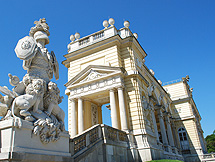 Beyond the palace itself, rising on a hill overlooking the grounds in the Gloriette, an arched “folly” designed as a triumphal gate with sweeping views of the grounds, palace and city beyond from the top viewing terrace. Grand sweeping steps lead to the corwning architectural feature of the park, built in 1775, designed by royal architect Hohenburg. The Gloriette is reached by an uphill walk of diagonal winding paths behind the sculptured Neptune Fountain.
Beyond the palace itself, rising on a hill overlooking the grounds in the Gloriette, an arched “folly” designed as a triumphal gate with sweeping views of the grounds, palace and city beyond from the top viewing terrace. Grand sweeping steps lead to the corwning architectural feature of the park, built in 1775, designed by royal architect Hohenburg. The Gloriette is reached by an uphill walk of diagonal winding paths behind the sculptured Neptune Fountain.
Schönbrunn Zoo
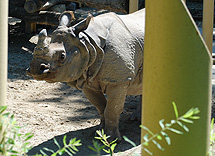 The park is so big it is the location of the Vienna Zoo, the Tiergarten Schönbrunn. It is noted as the world’s first zoo, established as a private royal menagerie in the palce park in 1752. The zoo is now managed as any modern zoo, but with a unique fusion of culture, nature and Baroque buildings, housing over 500 species of animals in the heart of the palce grounds.
The park is so big it is the location of the Vienna Zoo, the Tiergarten Schönbrunn. It is noted as the world’s first zoo, established as a private royal menagerie in the palce park in 1752. The zoo is now managed as any modern zoo, but with a unique fusion of culture, nature and Baroque buildings, housing over 500 species of animals in the heart of the palce grounds.
The Labyrinth
Laid out as an entrainment for royal guests strolling through the grounds, intended for casual encounters, the Schönbrunn Maze has always been one of the highlights of the palace park. Rebuilt and re-opened in 1999, the maze invites visitors to stroll within its secret pathways and discover hidden installations.
Children’s Museum
Located in the west wing of the palace, the Childrens Museum offers a opportunity for modern kids to get an insight into the lives of imperial children of the past with a chance to play dress-up as princes and princesses, with other activities.
The Great Palm House
Commissioned by Emperor Franz Joseph I in 1880, as a botanical exhibit for exotic flora, designed by court architect Franz Segenschmid, the metal and glass hothouse enclosure in the shape of bell domes, houses part of the botanical collection of the Austrian Federal Gardens, including a 68 feet tall palm tree as its namesake and the world’s largest waterlily.
Imperial Coach Collection
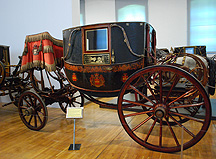 In the former stables can be found the imperial coach collection. Requiring a separate admission, here you’ll find the amazing assortment of carriages which bore the royal personages, from Sisi’s riding gear to the grand gold encrusted Imperial Coronation Coach (see Imperial Coach Museum Vienna).
In the former stables can be found the imperial coach collection. Requiring a separate admission, here you’ll find the amazing assortment of carriages which bore the royal personages, from Sisi’s riding gear to the grand gold encrusted Imperial Coronation Coach (see Imperial Coach Museum Vienna).
Visiting Schönbrunn Palace
The Schönbrunn Palace is open daily, including public holidays from 8:30 in the morning to 5 or 6 pm depending on the time of year. The ticket office just inside the main gate across the massive cobble stone plaza opens at 8:15. Visitors to Schonbrunn can choose between a 22-room Imperial Tour and the 40-room Grand Tour. The self–guide audio tours for adults cost €11.50 for the Imperial and €14.50 for the Grand Tour, and €8.50/9.50 respectively for children. Guided tours are also available, but in German, or other languages by arrangement. The tours have timed starting points as the palace is a busy place with many group tours. Schonbrunn Palace also offers tours for the hearing impaired with an iPod touch video including a sign language interpreter and museum Sign Language Guide.
Getting to Schonbrunn is an easy trip on the U4 line from central Vienna to either the Schonbrunn or Hietzing stops, then a 5 minute walk to the main gate or Tram 10 or 58 to Schonbrunn station. If you come in late November to December, a Christmas Market is held just in front of the palace (see Austria Christmas Markets). © Bargain Travel EuropeFind best hotel and travel deals in Vienna on TripAdvisor
Web Info
Schonbrunn
Palace
These articles are copyrighted and the sole property of Bargain Travel Europe and WLPV, LLC. and may not be copied or reprinted without permission.
SEE ALSO:
IMPERIAL TREASURE CHAMBER IN VIENNA
VIENNA MOZART CONCERTS FAMOUS VIENNA CAFÉS & CONFECTIONTRICK FOUNTAIN OF HELLBRUNN PALACE
HABSBURG ARMS & ARMOR COLLECTION

